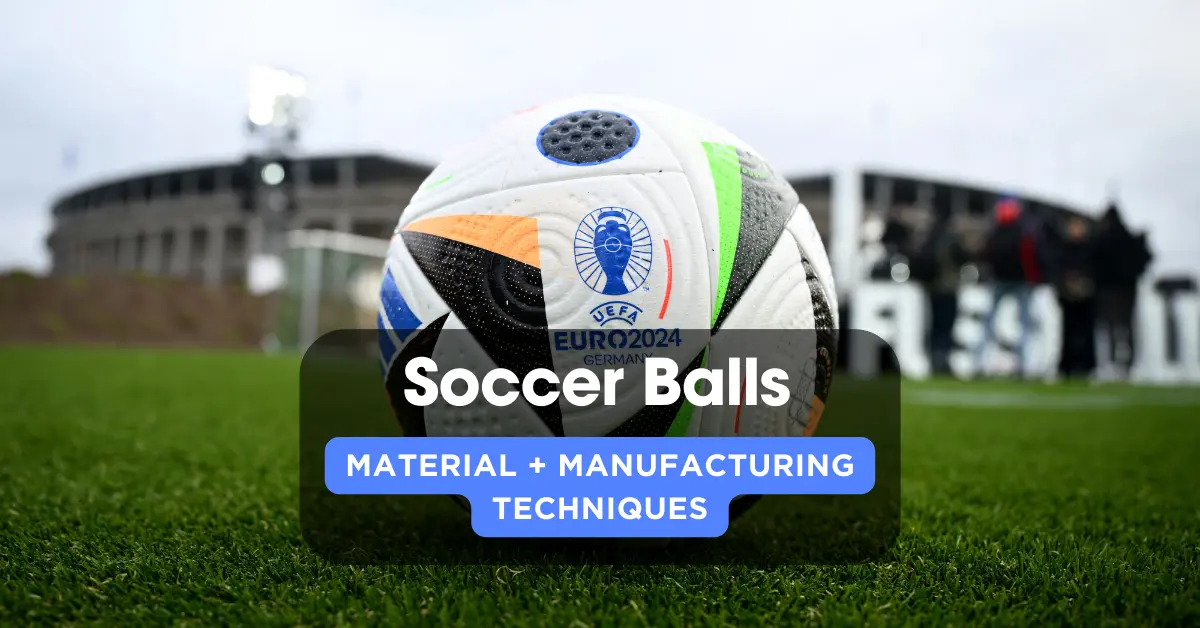How Are Soccer Balls Made In 2024? (Material + Manufacturing Techniques)
The game of soccer is played with a round ball that is kicked by the players. Soccer balls have undergone a long evolution from their origin to the modern designs used today. And now, we are going to see how soccer balls are made.
Soccer balls are made using complex steps, and they go through multiple stages of quality control before they hit the mass market. Most balls use rubber or latex core with a polyurethane or PVC outer layer.
You can only shoot a soccer ball properly if the ball is good and has proper shape and durability. And modern makers take care of all the needs of soccer players. So now, let’s take a deep dive into the realm of the soccer ball manufacturing process.
Origin And Evolution Of Soccer Balls
The origin of soccer balls can be traced back to the ancient civilizations of China, Greece, and Rome. These early balls were made of materials such as animal bladders, stitched leather, and rubber.
However, it was in the 19th century that soccer balls began to take a more recognizable form. The first standardized soccer ball was made in 1862 by Charles Goodyear, who introduced vulcanized rubber, making the ball more durable.
Over the years, the soccer ball underwent further evolution. In 1930, the first World Cup was held, and a new design was introduced with 12 panels instead of 18, which made the ball more round and easier to control.
In 1970, the Telstar ball was introduced for the FIFA World Cup in Mexico, which had 32 black and white panels, and this became the standard design for many years.
Bonus: What Is Striker In Soccer? (Forward Positions – Explained!)
Designs Of Modern Soccer Balls
Modern soccer balls come in various designs, each with its own unique features. Some of the popular designs are:
- Adidas Telstar: Has 6 identical panels and was used in the 2018 World Cup. The design is a nod to the 1970 Telstar ball, but it has been updated with new technology.
- Nike Mercurial: It comes with a 4-panel design and is known for its aerodynamic grooves that help to stabilize the ball in the air.
- Puma evoPower: This has a 12-panel design and is designed to enhance the power and accuracy of shots.
- Umbro Neo Pro: Neo Pro has a 14-panel design and is known for its soft touch and accurate flight.
- Select Brillant Super: Has a 32-panel design and is made of high-quality materials for enhanced durability and performance.
Most manufacturers these days focus on designing lighter balls that are easier to control. With lighter soccer balls, you can easily execute trapping skills and other maneuverings easily.
Raw Materials Of Modern Balls
Modern soccer balls are made of a variety of materials, each with its own unique properties. Some of the raw materials used in soccer balls are:
- Synthetic Leather: Provides durability, water resistance, and a consistent feel.
- Rubber Bladders: Holds air inside the ball and gives the ball its shape.
- Polyester: Used for stitching the panels together and provides strength and durability.
- Polyurethane: Used for coating the surface of the ball to make it water-resistant and durable.
Manufacturers these days experiment with various materials and stitching patterns to ensure the ideal weight and pressure of soccer balls. And in recent years, we have already seen several new materials incorporated into the standard manufacturing process.
Read More: What Is CDM In Soccer? (Central Defensive Midfielder – Explained!)
Manufacturing Process Of Soccer Balls
The manufacturing process of soccer balls involves several steps, and those are pretty complex. Besides, different sports equipment makers use different steps to get their final product. But the standard steps are:
- Cutting the Panels: The first step is to cut the panels out of the raw material.
- Stitching the Panels: The panels are then stitched together to form the ball.
- Adding the Bladder: The bladder is inserted into the ball and inflated.
- Coating the Surface: The surface of the ball is coated with polyurethane to make it water-resistant and durable.
- Quality Control: The ball undergoes several quality control checks to ensure that it meets the required standards.
Many great soccer players have their personal choices in soccer balls. And manufacturers also take their advice while designing a new ball.
Quality Control Process And Tests
To ensure the quality of soccer balls, they undergo several rigorous tests. And each ball needs to pass every test before they actually get released for the players. The steps are:
- Size and Weight: The ball is weighed and measured to ensure that it meets the required size and weight.
- Roundness: The ball is tested for roundness to ensure that it meets the required standard.
- Rebound: The ball is dropped from a height of 2 meters, and its rebound is measured to ensure that it meets the required standard.
- Water Absorption: The ball is placed in water for a specific time and then weighed to measure how much water it has absorbed.
- Pressure Loss: The ball is inflated to a specific pressure and left for a period of time to check how much pressure it has lost.
Soccer ball manufacturers often hire players to test their balls at soccer stadiums. They mainly do it to analyze the real-world performance of their balls.

New Technologies Used In Modern Soccer Balls
New technologies have been introduced in modern soccer balls to enhance their performance and durability. Some of these technologies are:
- Thermally Bonded Panels: In this process, the panels are fused together using heat and pressure, which creates a seamless and more aerodynamic ball.
- Textured Surface: Some soccer balls have a textured surface, which helps to improve grip and control.
- Foam Layer: Some soccer balls have a foam layer between the panels, which enhances the ball’s feel and touch.
- High-Visibility Coatings: These coatings make the ball more visible in low-light conditions, making it easier for players to see the ball.
- GPS Tracking: Some soccer balls have GPS technology embedded in them, which allows coaches to track the ball’s movement and analyze player performance.
- Aerodynamic Grooves: These grooves help to stabilize the ball in the air and improve its accuracy.
Some of the best soccer leagues are now incorporating newer technologies in their match balls and also on their stadiums. And in the coming years, we are going to see a revolution in ball technology.
You May Like: Why Do Soccer Players Flop So Much? (Penalty Chances!)
Upcoming Technologies in Balls
Most sports manufacturers have their R&D teams that work day and night to incorporate newer technologies to have the edge over their competitors. There are several upcoming technologies in soccer balls, such as:
- Smart Chips: Smart chips embedded in soccer balls will allow players and coaches to track performance metrics, such as speed, spin, and distance.
- Self-Inflating Bladders: Self-inflating bladders will allow soccer balls to maintain their optimal pressure without the need for constant manual inflation.
Many new technologies are also in the incubating stage that will make easier to juggle a soccer ball and shoot accurately with them.
Popular Balls and Their Materials and Technologies
Popular soccer jersey makers, such as Adidas and Nike, focus on their materials and new technologies. And here is a table of 5 popular soccer balls with their core and outer material and special technology.
| Soccer Ball | Core Material | Outer Material | Special Technology |
| Adidas Telstar | Rubber Bladder | Synthetic Leather | NFC chip for tracking |
| Nike Mercurial | Latex Bladder | Textured Synthetic Leather | Aerowtrac grooves |
| Puma evoPower | Latex Bladder | Polyurethane | AccuFoam |
| Umbro Neo Pro | Latex Bladder | TPU | 14-panel design |
| Select Brillant Super | Latex Bladder | PU | Hand-stitched |
Some of the greatest soccer goalkeepers of all time are in touch with the manufacturers. They give their input about the flight and performance of balls so that manufacturers can work on them.
Difference Between Match Balls And Practice Balls
Popular soccer players, such as Cristiano Ronaldo and Lionel Messi, prefer to use different balls during their training and in actual matches. Match balls and practice balls are designed differently. Here’s a comparison table:
| Aspect | Match Balls | Practice Balls |
| Design | Consistent | Inconsistent |
| Materials | High-Quality | Lower-Quality |
| Cost | Expensive | Affordable |
| Intended Use | Official | Training |
| Quality Standards | Strict | Less Strict |
Popular soccer competitions, such as the English Premier League, La Liga, and Bundesliga, offer match balls to every listed club beforehand. In that way, players can play and get accustomed to the ball easily.
Our Popular Post: How Do Soccer Loans Work? Definition & Facts In 2024

Final Note
Soccer balls have come a long way from their ancient origins to the modern designs used today. They are made from a variety of materials and undergo several tests to ensure their quality.
With the use of new technologies, soccer balls are becoming more innovative and performance-oriented. So that’s all for today, soccer heads! Feel free to drop your queries and start a conversation with us in the comment section.

